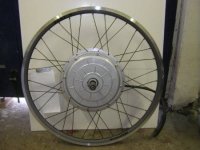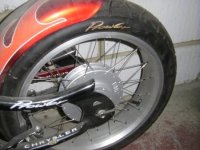MitchJi
10 MW
Hi Bob,
For high quality work with a good warranty I don't think £75 is totally unreasonable (although you might do better with a lower price). Gravy charges about $100 with a lifetime warranty on the build:
http://www.gravyprowheels.com/95.html
Of course he has a long-standing reputation with a lot of repeat customers:
http://www.gravyprowheels.com/116.html
Is £50 the total price or just the powder coating? Roughly what would you charge for a box (no electronics) including powder coating?
B0B said:I've had a chance to reconsider my pricing and £75 does seem to be stretching it a bit.
For high quality work with a good warranty I don't think £75 is totally unreasonable (although you might do better with a lower price). Gravy charges about $100 with a lifetime warranty on the build:
http://www.gravyprowheels.com/95.html
Of course he has a long-standing reputation with a lot of repeat customers:
http://www.gravyprowheels.com/116.html
STEVE "Gravy" GRAVENITES
A native of Marin County, California, Gravy was there (circa 1976), riding with the early pioneers of
mountain biking Joe Breeze, Gary Fisher, Steve Potts and Charlie Cunningham.
Since then, Gravy has built wheels and bikes for National and World Champions TINKER JUAREZ, STEVE LARSEN, JURGEN BENEKE, DAVE CULLINAN, MISSY GIOVE, MYLES ROCKWELL and ALISON SYDOR. Along with notable riders
Elke Brutsaert, Colin Bailey, Sara Ballentine, Jimmy Deaton, Curly & Sara Ellis, Rishi Grewai, Tammy Jaques, Mike King,
April Lawyer, Tattoo Lou, Cail Noble, Ned Overend, Jacquie Phelan, Daryl Price, Kurt Stockton and Kurt Vories.
Gravy has witnessed and participated in the entire history of the sport of mountain biking. He was wrenching for MISSY and MILES when they both medaled at the Mountain Bike World Championships. Gravy wrenched for the Volvo/Cannondale Mountain Bike Race Team through a zero-mechanical-failure season in 1994.
Throughout the years, Gravy has learned his trade from the best mechanics and bike builders in the world. His mentors include Buck Berardi, Bill Woodal & Jim Ingram from Campagnolo, John Parker & Frank The Welder from Yeti Cycles and Tracey Wilde.
B0B said:The box in my bike was made by myself at work. I made the battery pack of 10ah headway cells at 48v to fit the shape of the box. Also inside are all the connections between controller, motor, on/off switch, charger input plug, LVC plus controller too.
It's a bit cramped, and as it is the MK1 box. There are still some mods needed to make it 100%. I need to make the next one a few millimeters wider and get an extra couple of mil out of the hight too!! It's made from sheet aluminum and MIG welded for joining! I will be starting to offer this service for other e-bikers as and when they want it! If you know the dimensions of the area to be filled it can take a day or two to get it from nothing to finished. Mine's not powder coated yet, but can be done locally to me for around £50+, style/colour dependent.
Is £50 the total price or just the powder coating? Roughly what would you charge for a box (no electronics) including powder coating?



